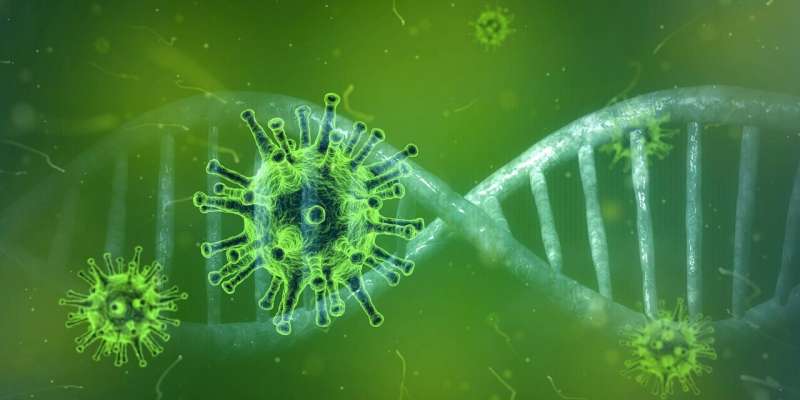
A University of Florida research team is helping to build the case that coronaviruses move between animals and people at a more frequent rate than previously understood.
Earlier this year, the team reported the first known instance of a coronavirus common in pigs to have “spilled over” into people. Spillovers refer to events where a virus that is adapted to a certain kind of host—say, a dog, or pig—acquires features that allow it to infect an entirely different species of host, such as a person.
In their newest work, the team retrospectively uncovered an instance where a coronavirus known from dogs, called a canine coronavirus, infected at least one person visiting Haiti in early 2017. The infected person had a mild illness with fever and fatigue. The new work published in Clinical Infectious Diseases on Oct. 28,2021.
In an unusual twist, the virus was determined to closely match a canine coronavirus reported earlier in 2021 from Malaysia where it caused pneumonia-like symptoms in several people. In neither instance was there evidence of further spread of the virus within human populations.
From Malaysia to Haiti
The UF team is part of a larger effort to understand unexplained illnesses with fevers in Haiti. They have analyzed biosamples from study participants in Haiti’s Gressier region since 2013. When participants have a fever but test negative for viruses known to be in the area—such as Zika, chikungunya, or dengue—they begin a process of laboratory tests with the goal of detecting and identifying unknown viruses.
In early 2017, a US medical team member traveled to Haiti and then fell ill upon returning home. Fever and tiredness were the individual’s main symptoms. At the time, there was an outbreak of Zika virus in Haiti, but tests for this were negative. The team took portions of a urine sample obtained from the medical team member and used it to inoculate cell cultures. They then observed visual changes take place in the cells consistent with a viral infection.
A diagnostic test that confirms the presence of human endemic coronaviruses gave a signal that indicated a coronavirus was present, but it was not strong enough to match with one that normally circulates in people. They next tested for specific coronavirus species using RT-PCR tests on portions of the inoculated cell culture, but these were also all negative.
This led the team to use an “unbiased amplification and sequencing” approach. This allowed them to copy portions of the genetic sequence for the virus that was present in the cell culture. On a hunch, the team used advanced laboratory sequencing techniques to evaluate if the viral material they had was similar to a newly discovered canine coronavirus strain that had been recently found in people in Malaysia. That spillover was reported in Clinical Infectious Diseases in May.
It wasn’t just similar, it was a 99.4% match. But it differed slightly in one way: the sample under analysis by the UF team appeared to have undergone recombination, a form of genetic mixing, with other dog coronaviruses, as well as coronaviruses from pigs and cats.
How often do novel coronaviruses spill into people?
Coronaviruses were once an obscure and arcane area of research, even among virologists. This family of viruses were known to occur in birds and mammals and to drive patterns of seasonal cold symptoms in people. But they weren’t thought to frequently cross species barriers between animals and people.
Then came outbreaks of severe acute respiratory syndrome, or SARS in 2002 and Middle East respiratory syndrome (MERS), in 2012. Seven years later, COVID-19 rapidly spread across the world.
All of these outbreaks were due to coronaviruses common in certain animals gaining access to human hosts. And each caused more severe illness and death than endemic coronavirus strains that cause the common human cold. The seeming increasing frequency with which disease-causing coronavirus strains are appearing in people has left many researchers wanting to know more about this diverse group of viruses.
Dogs, pigs, and people: Coronaviruses like ’em all
Usually, most of these spillovers don’t transmit beyond their new human host. They simply reach a dead end. But the possibility that these viruses could one day acquire genes that cause severe disease in people underscores the need to know how frequently these spillovers occur and which types of coronaviruses are more prone to spillover.
“These concerns are underscored by the apparent ease with which this canine coronavirus appears to have acquired genes from other canine coronaviruses, as well as coronaviruses from pigs and cats,” says UF Emerging Pathogens Director J. Glenn Morris, Jr., M.D., M.P.H & T.M. who is the senior author to the study “It is likely that this exchange of genes and movement among hosts has occurred for many years, as part of normal evolution.”
Better knowledge = reduced risk for future outbreaks
Many experts believe that the best way to prevent another coronavirus-driven pandemic is to better understand these viruses in both animals and people. Detecting and identifying previously unknown coronaviruses in animals, for example, will better position scientists to develop diagnostic tests that can be used in routine surveillance and monitoring.
Source: Read Full Article
